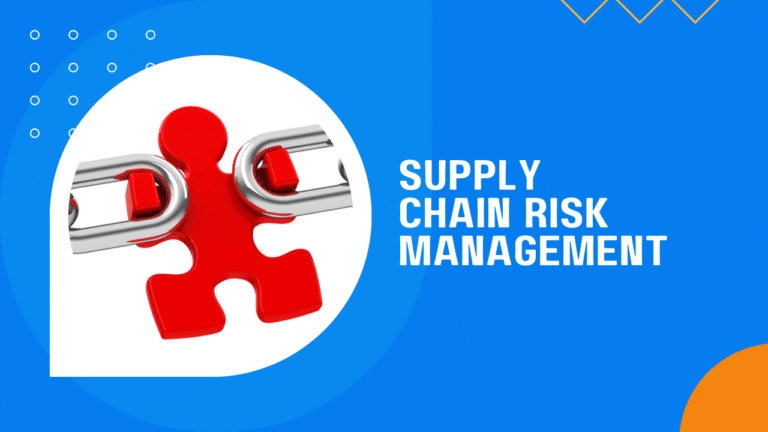In today’s fast-paced business world, managing the risks in your supply chain is more important than ever. Supply Chain Risk Management (SCRM) is all about understanding, managing, and reducing the risks that can disrupt your supply chain. It’s not just about preventing losses; it’s also about ensuring that your business runs smoothly and efficiently.
Every business that deals with a supply chain faces a variety of risks. These can range from unexpected delays to more serious issues like natural disasters or cyber attacks. The goal of SCRM is to identify these risks before they become problems and to develop strategies to deal with them effectively.
We’ll explore what supply chain risk management involves, why it’s important for your business, and how you can identify and reduce the risks in your supply chain. Whether you’re a seasoned professional in logistics or just starting to explore the field, this article will provide valuable insights into making your supply chain more resilient and secure.
Identifying Risks in the Supply Chain
Understanding and identifying potential risks in your supply chain is a crucial step in supply chain management. This process involves a thorough examination of your supply chain to pinpoint areas that could be vulnerable to disruptions. Let’s look at how businesses can effectively identify these risks.
Techniques for Risk Identification
Supply Chain Mapping: This involves creating a detailed map of your supply chain, including suppliers, transport routes, and distribution centers. This visual representation helps in identifying critical nodes and links where risks could arise.
Historical Analysis: Reviewing past incidents and disruptions can provide valuable insights. By analyzing these events, you can identify patterns and common risk factors in your supply chain.
Risk Assessment Workshops: Bringing together various stakeholders, including suppliers, logistics providers, and internal teams, for brainstorming sessions can help uncover risks that might not be immediately apparent.
External Intelligence Gathering: Staying informed about global events, market trends, and technological advancements can help anticipate risks that arise from external factors.
Assessing the Impact of Potential Disruptions
Once potential risks are identified, the next step is to assess their potential impact. This involves considering the likelihood of each risk occurring and the extent of disruption it could cause. Key considerations include:
- Financial Impact: Estimating the potential cost implications of disruptions, such as lost sales, increased operational costs, or penalties for non-compliance.
- Operational Impact: Assessing how disruptions could affect production, delivery schedules, and overall operational efficiency.
- Reputational Impact: Considering the potential damage to your brand and customer relationships if supply chain disruptions lead to delays or quality issues.
- Regulatory Impact: Understanding the implications of disruptions in the context of regulatory compliance and legal obligations.
By systematically identifying and assessing risks, businesses can develop a more robust strategy for managing their supply chains, ensuring they are better prepared for potential disruptions.You
Strategies for Mitigating Supply Chain Risks
Mitigating risks in the supply chain is a proactive approach to ensure business continuity and efficiency. Here are some key strategies:
Best Practices for Risk Mitigation
Diversification of Suppliers: Relying on a single supplier can be risky. Diversifying your supplier base across different geographical locations can reduce the risk of disruptions. This strategy ensures that if one supplier faces issues, others can fill the gap.
Building Strong Relationships with Suppliers: Establishing strong, collaborative relationships with suppliers can lead to better communication and understanding. This can help in quickly resolving issues and finding alternative solutions during crises.
Implementing Robust Inventory Management: Effective inventory management, including safety stocks and buffer inventories, can be a safeguard against supply chain disruptions. This approach helps in managing sudden spikes in demand or supply shortages.
Regular Risk Assessments and Reviews: Continuously assessing and reviewing supply chain processes helps in identifying potential risks early. Regular audits and risk assessments ensure that the supply chain adapts to changing environments and threats.
Examples of Successful Supply Chain Risk Management
Example 1: Automotive Industry: A leading automotive company implemented a dual-sourcing strategy for its critical components. This approach helped them maintain production during a major supplier’s factory shutdown.
Example 2: Retail Sector: A global retail chain used predictive analytics to forecast demand and adjust inventory levels accordingly. This strategy helped them avoid overstocking and understocking, especially during peak seasons.
Example 3: Pharmaceutical Industry: A pharmaceutical company established a risk management team dedicated to monitoring and managing supply chain risks. This team’s proactive approach helped the company navigate through regulatory changes and market volatility effectively.
A combination of diversification, strong supplier relationships, effective inventory management, and continuous risk assessments forms the backbone of successful supply chain risk mitigation strategies. These practices not only prevent disruptions but also ensure a resilient and responsive supply chain.
Tools and Technologies in SCRM
The advancement of technology has significantly enhanced the capabilities of Supply Chain Risk Management (SCRM). Here’s an overview of the tools and technologies that are playing a pivotal role in this area.
Overview of Tools and Technologies Aiding in Risk Management
Supply Chain Management Software: This software offers an integrated platform for managing all aspects of the supply chain. Features like real-time tracking, inventory management, and supplier performance metrics are crucial for identifying and managing risks.
Predictive Analytics: By analyzing historical data, predictive analytics can forecast future trends and potential disruptions. This technology helps businesses prepare for and mitigate risks before they occur.
Internet of Things (IoT): IoT devices, such as sensors and RFID tags, provide real-time data on the movement and condition of goods. This information is vital for monitoring the supply chain and quickly identifying any irregularities or potential risks.
How Technology Can Enhance Supply Chain Resilience
Real-Time Visibility: Technologies like IoT and SCM software provide real-time visibility into the supply chain. This visibility is crucial for quickly identifying and responding to risks.
Data-Driven Decision Making: Tools like predictive analytics enable businesses to make informed decisions based on data trends and forecasts. This approach reduces the reliance on guesswork and enhances the accuracy of risk management strategies.
Enhanced Collaboration: Technologies facilitate better communication and collaboration among all stakeholders in the supply chain. This improved collaboration is key to managing risks effectively and ensuring a cohesive response to any disruptions.
Automated Risk Detection and Response: Advanced technologies can automate the detection of potential risks and initiate pre-defined response actions. This automation increases the speed and efficiency of risk management.
Conclusion
We’ve explored the critical aspects of Supply Chain Risk Management (SCRM), highlighting its importance in today’s interconnected and fast-paced business environment. From identifying potential risks in the supply chain to implementing strategies for their mitigation, we’ve covered the essential steps businesses need to take to safeguard their operations.
Effective SCRM is not just about responding to challenges as they arise but about anticipating and preparing for potential disruptions. It requires a comprehensive understanding of the supply chain, a strategic approach to risk management, and the adoption of advanced technologies. By embracing these principles, businesses can ensure a more resilient, responsive, and efficient supply chain, ready to face the challenges of the modern business landscape.









